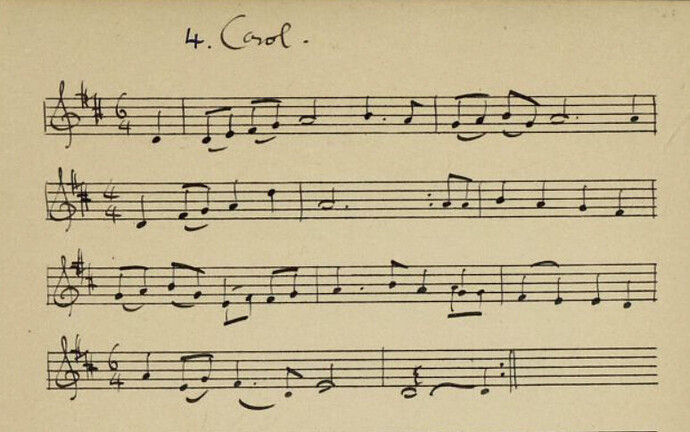This is a notation rather than a Dorico question ![]() . I’ve been using Dorico to transcribe some of Clive Carey’s notebooks from the Vaughan Williams Memorial Library (much easier to organise thanks to flows). He often makes use of sign like the dots in a repeat barline, but without the barline - you can see this in bar 4 of the attached image just before the two quavers. Has anyone come across this before and do you think it’s intended as shorthand for a start repeat?
. I’ve been using Dorico to transcribe some of Clive Carey’s notebooks from the Vaughan Williams Memorial Library (much easier to organise thanks to flows). He often makes use of sign like the dots in a repeat barline, but without the barline - you can see this in bar 4 of the attached image just before the two quavers. Has anyone come across this before and do you think it’s intended as shorthand for a start repeat?
It appears to be a mid-measure backwards repeat.
Isn’t it the beginning of a repeat? The corresponding dots are at the end, so the last two and a half lines of music are repeated. The metre would be something like 8.6.8.8.6.8.8.6. He just hasn’t put in the barline-like part of the normal symbol - it is a notebook!
Michael Aves
It is a sign to jump back to.
Written this way probably out of aesthetical reasons,
and it does not block the flow of the simple tune.
Thanks all, yes start repeat does seem to make most sense. I was impressed at how easy this was to enter in Dorico, the attached screen shot is the result of around 10 minutes work. Particularly impressive was how putting the end repeat before the rest in the last bar automatically hid the rest and spaced the bar properly.
Nice.
You can hide the instrument names via Layout Options (I think the indentation of the first system is configured in there too). Notation Options will sort out the beaming too. Finally, add a second voice to show the different rhythms in the repeated section, and use Starts/End voice properties to hide unwanted rests.
![]()
P.S. Two notes are incorrect in bar 3.
Clumsy of me; that’s what I meant. Since I think of a regular repeat pointing backwards, when I think of a repeat operating in a backward manner, I mean the starting repeat. The notes seem to confirm that since RVW seems to be indicating slightly different rhythms for different (unwritten) words in the repeated section of the second part.
Thanks Ian, I’d been trying to remember how to hide the instrument names and do need to add the second voice, and check that the notes are correct!
I always have to think when describing start and end repeats.
FWIW Lilypond includes this as a type of bar line, independent of the dots forming part of a repeat barline.

To my eyes, the last measure looks like a whole note tied to a quarter (with a scribbled out stem), thereby giving a 5 count bar, which makes sense whether it repeats back to beginning or to the dots in question.
I’ve come across several songs in the collection that have second voices before and after the double dot, and they do all make rhythmic sense from the beginning or the double dot. Clive Carey did write notes against each song, but unlike his notation, his handwriting is hard to decipher. A fun way to learn Dorico though.

